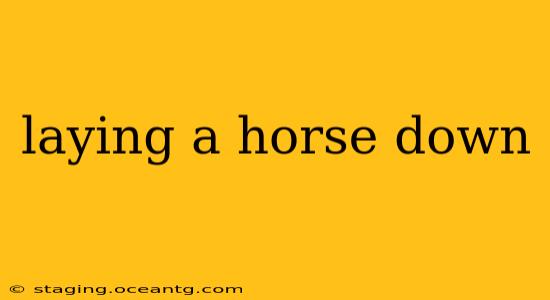Laying a horse down is not a task for the faint of heart or inexperienced handler. It requires significant skill, knowledge, and a calm, confident approach. This procedure is generally only necessary in specific veterinary situations, such as during surgery, certain medical procedures, or in emergency situations where the horse needs to be restrained for its own safety. Never attempt to lay a horse down unless you have received proper training and are under the direct supervision of a veterinarian or experienced equine professional.
This guide is intended for experienced horse handlers who already possess a strong understanding of equine behavior and handling techniques. It is not a tutorial for beginners. Improper techniques can lead to serious injury for both the horse and the handler.
Why Would You Need to Lay a Horse Down?
There are several reasons why a veterinarian might need to lay a horse down:
- Veterinary Procedures: Certain procedures, such as surgery or ultrasound examinations, are easier and safer to perform when the horse is recumbent (lying down).
- Emergency Situations: In cases of severe injury or illness, laying a horse down can help stabilize them and prevent further injury.
- Administering Medications: Some medications or treatments may be more effectively administered when the horse is lying down.
- Transport: In some instances, laying a horse down may be necessary for safe transport.
How to Safely Lay a Horse Down: A Step-by-Step Approach (For Experienced Handlers Only)
This section outlines the general principles involved. Specific techniques vary depending on the situation and the individual horse. Always follow the instructions of the veterinarian or experienced equine professional.
-
Preparation: Ensure the area is safe and level, free of obstacles that could cause injury. Have all necessary equipment readily available. This may include ropes, straps, and possibly padding.
-
Assessing the Horse: Observe the horse's behavior and temperament. A calm, cooperative horse will make the process significantly easier.
-
Using a Trained Team: Never attempt this alone. A minimum of two experienced handlers, working in coordination, is necessary. One handler focuses on the horse's head and neck, while the other manages the hindquarters.
-
Controlled Positioning: Using ropes or straps, gently guide the horse into a lying position. Avoid any sudden movements or jerking motions. This usually involves carefully moving the horse's weight in a controlled manner, encouraging it to lower its hindquarters and then its front legs.
-
Maintaining Control: Once the horse is down, maintain calm control. Continuously monitor the horse's breathing and vital signs.
-
Post-Procedure Care: After the procedure, carefully help the horse rise to its feet. Provide support and ensure it's stable.
What if a Horse Falls Down Unexpectedly?
If a horse falls unexpectedly, remain calm. Assess the situation quickly and determine if the horse is injured. Call your veterinarian immediately. Do not attempt to move the horse unless absolutely necessary to prevent further injury.
What are the risks involved in laying a horse down?
The risks involved are significant. Improper technique can lead to:
- Injury to the Horse: Broken bones, muscle strains, or other injuries are possible.
- Injury to the Handler(s): Being kicked, bitten, or crushed is a real possibility.
- Stress to the Horse: The experience can be stressful and frightening for the horse.
What equipment is needed to lay a horse down?
The specific equipment will depend on the situation and the veterinarian's instructions. It may include:
- Ropes: Strong, non-slip ropes are essential for controlled guidance.
- Straps: Similar to ropes, but offer a softer, more padded option.
- Padding: Padding can help to cushion the horse and minimize the risk of injury.
Can I lay my horse down myself at home?
No. Laying a horse down is a complex procedure requiring specialized knowledge and training. Attempting to do so without proper guidance can seriously injure the horse and the handler. Always consult a veterinarian.
This article provides only a general overview and is not a substitute for professional training. Never attempt to lay a horse down unless you are a trained and experienced equine professional working under veterinary supervision. Improper techniques can have potentially devastating consequences.
